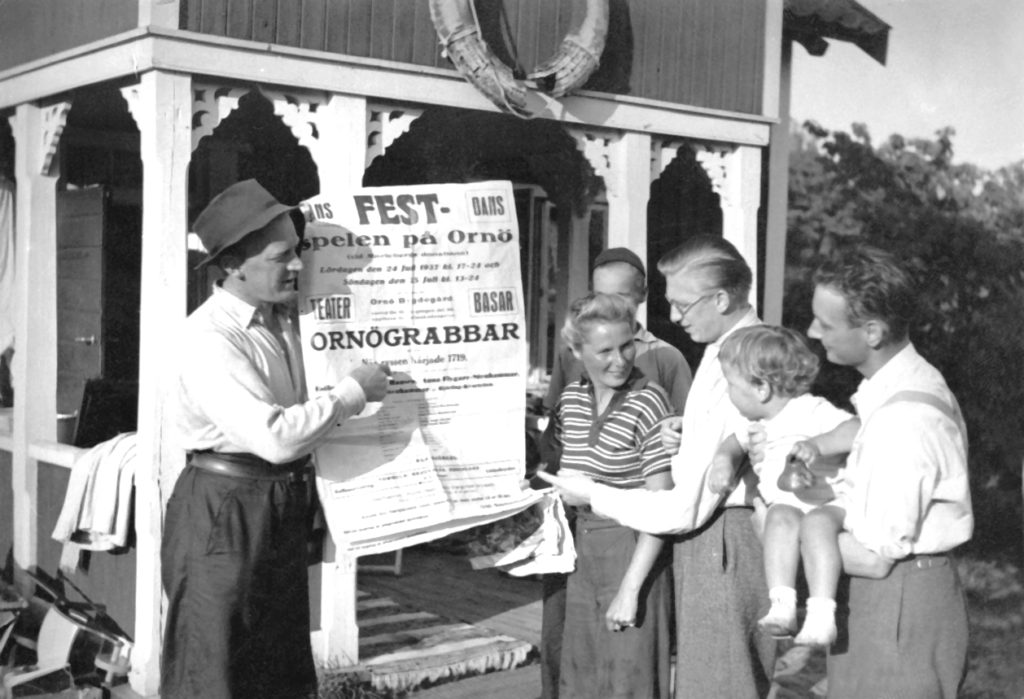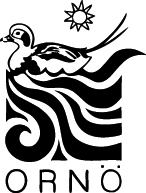· Start · Next sign · Previous sign · Swedish
SJÖBERG POINT – SJÖBERG AND BERGMAN
Painters weren’t the only artists who found Ornö enchanting. Two of Sweden’s most prominent film directors have stayed here, been inspired and made films on Ornö.
Film director Alf Sjöberg rented a croft on western Ornö in the summer of 1930 and remained on the island. For many years, the Sjöberg family rented various houses before they could build their cottage here on the point. In later years, Alf and his wife built a house on Korpskär, a small island, not far from here.
Alf Sjöberg was an active man of culture on Ornö and contributed to the cultural life in many ways. When money needed to be raised for a community centre, Alf arranged the Ornö Plays. Professional and amateur actors alike shared the stage; the theme of the play was the 1719 ravages by the Russians in the Stockholm archipelago. Count Albert Stenbock and the island’s shopkeeper Carl-Oscar Sjöberg played the part of Carolingian soldiers, while miners from the Ornö feldspar mine played the part of Russian soldiers. In the Ornö Plays version, the Russians were forced to flee from the Swedes, which is not strictly how history unfolded during the Russian Pillage. In the 1940s and 1950s, Alf Sjöberg directed more performances.

Alf Sjöberg presents the poster for the Ornö Plays on the veranda at Morotsvik, 1937.
Two of Alf Sjöberg’s films were directly inspired by Ornö. Den blomstertid, from 1940, is a film about an idealistic parish clerk on an archipelago island who fights to establish a youth association together with the island teacher. The pastor is among those who oppose his idea. A group of workers from the feldspar mine also play an important role in the film.
Alf Sjöberg has said that the inspiration for the film’s main character was Filip Olsson, parish clerk and teacher on Ornö from 1929 until he retired in 1969.
“The parish clerk is based on a person who lived on my island. He fought hard for the establishment of a community centre, and succeeded in the end.”
In the film Ön, from 1966, the plot revolves around Count Magnus, whose father has perished during a sailing trip and whose mother has confined herself to an island. The real count on Ornö at this time was Otto Stenbock, whose grandfather Albert died during a sailing trip in nearby Gåsstensfjärden in 1904 and whose grandmother Rose often spent time on Tröja island, close to Ornö, after her husband’s death.
Ingmar Bergman was also captivated by the beauty of the archipelago, and in 1952, the film Summer with Monika was filmed on the outer islands beyond Ornö and Utö. This well-known film was shot mainly on Borgen, but also on Bodskär and Sadelöga. Harriet Andersson and Lars Ekborg played the parts of the young romantic couple Monika and Harry. During the production of the film, the film team stayed at the parish house on Ornö, the home of parish clerk and teacher Filip Olsson.
Lervassa Trail was produced by Ornö Museum in collaboration with Stockholms läns Hembygdsförbund and with funding from the Swedish National Heritage Board.

